Human Resource Management Practices & Legislation - Canary Wharf BTEC
VerifiedAdded on 2023/04/04
|19
|4463
|318
Report
AI Summary
This report provides an overview of Human Resource Management (HRM) practices within the context of a leading firm in Canary Wharf. It details the purpose and functions of HRM, including workforce planning and resourcing, recruitment and selection approaches, and the benefits of various HRM practices for both employers and employees. The effectiveness of HRM practices in raising organizational profits and productivity is evaluated, along with the importance of employee relations and the impact of employment legislation on HRM decision-making. The report also applies HRM practices in a work-related context, offering a comprehensive analysis of HRM's role in achieving organizational goals and maintaining a competitive advantage.
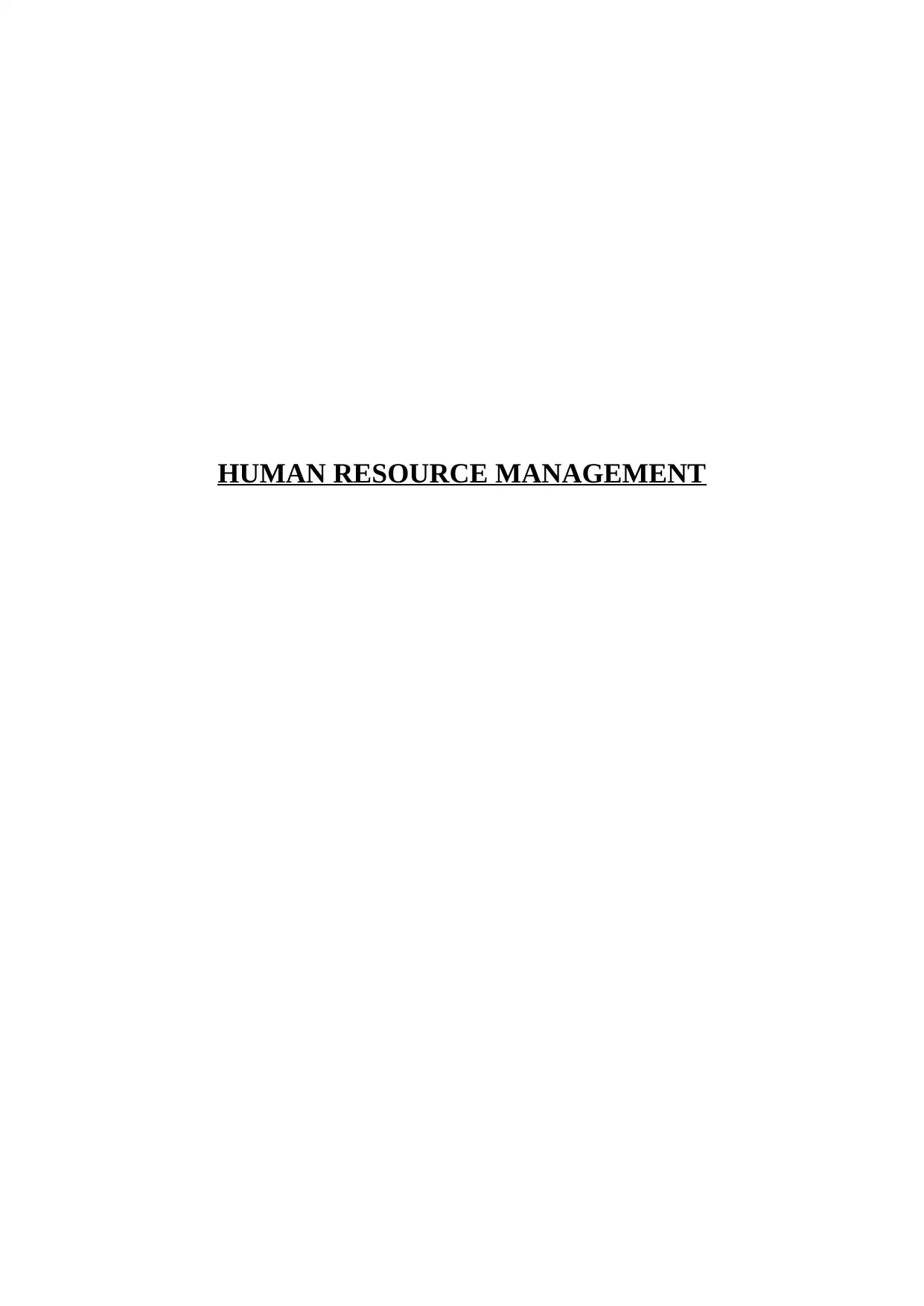
HUMAN RESOURCE MANAGEMENT
Paraphrase This Document
Need a fresh take? Get an instant paraphrase of this document with our AI Paraphraser
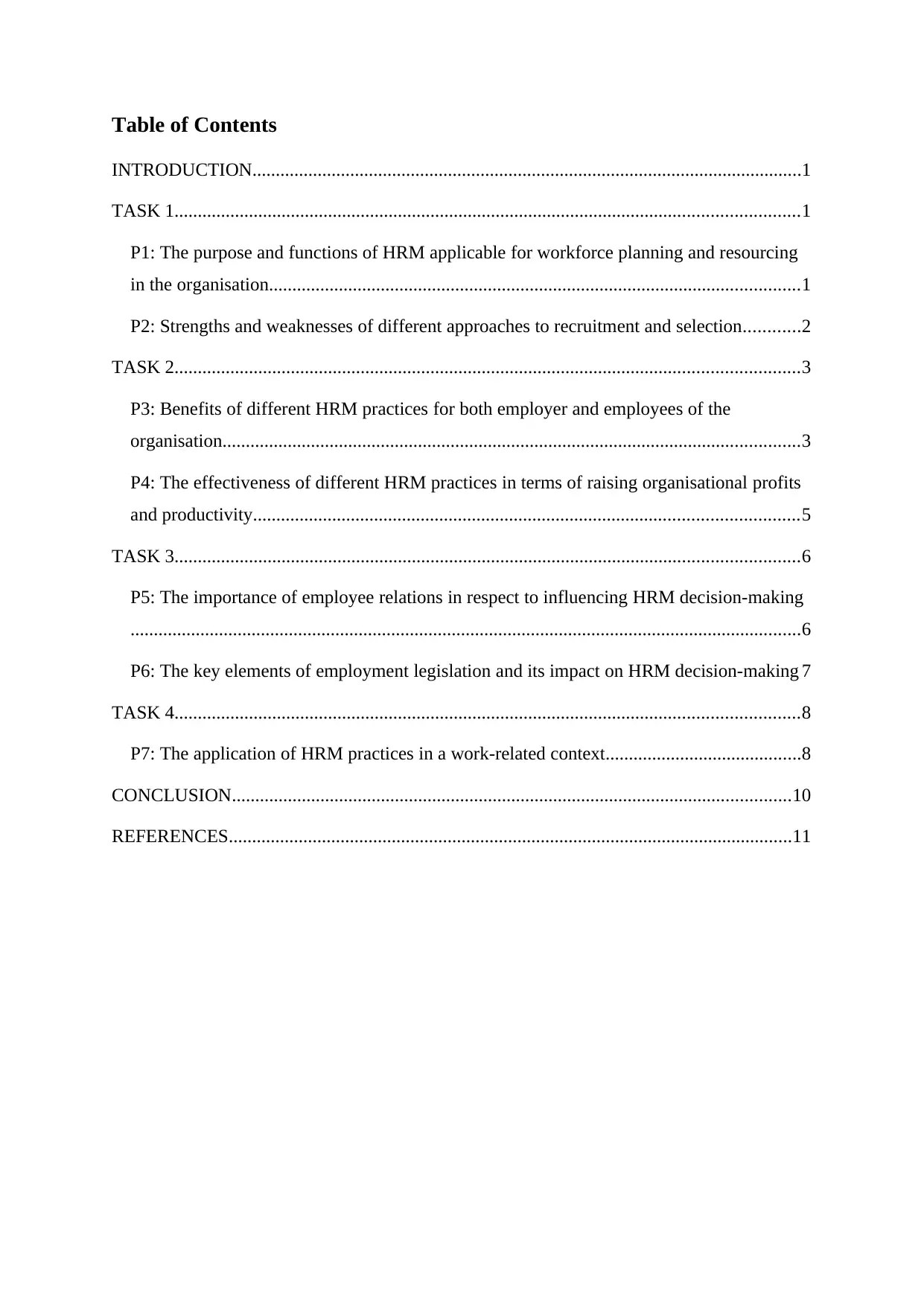
Table of Contents
INTRODUCTION......................................................................................................................1
TASK 1......................................................................................................................................1
P1: The purpose and functions of HRM applicable for workforce planning and resourcing
in the organisation..................................................................................................................1
P2: Strengths and weaknesses of different approaches to recruitment and selection............2
TASK 2......................................................................................................................................3
P3: Benefits of different HRM practices for both employer and employees of the
organisation............................................................................................................................3
P4: The effectiveness of different HRM practices in terms of raising organisational profits
and productivity.....................................................................................................................5
TASK 3......................................................................................................................................6
P5: The importance of employee relations in respect to influencing HRM decision-making
................................................................................................................................................6
P6: The key elements of employment legislation and its impact on HRM decision-making 7
TASK 4......................................................................................................................................8
P7: The application of HRM practices in a work-related context..........................................8
CONCLUSION........................................................................................................................10
REFERENCES.........................................................................................................................11
INTRODUCTION......................................................................................................................1
TASK 1......................................................................................................................................1
P1: The purpose and functions of HRM applicable for workforce planning and resourcing
in the organisation..................................................................................................................1
P2: Strengths and weaknesses of different approaches to recruitment and selection............2
TASK 2......................................................................................................................................3
P3: Benefits of different HRM practices for both employer and employees of the
organisation............................................................................................................................3
P4: The effectiveness of different HRM practices in terms of raising organisational profits
and productivity.....................................................................................................................5
TASK 3......................................................................................................................................6
P5: The importance of employee relations in respect to influencing HRM decision-making
................................................................................................................................................6
P6: The key elements of employment legislation and its impact on HRM decision-making 7
TASK 4......................................................................................................................................8
P7: The application of HRM practices in a work-related context..........................................8
CONCLUSION........................................................................................................................10
REFERENCES.........................................................................................................................11
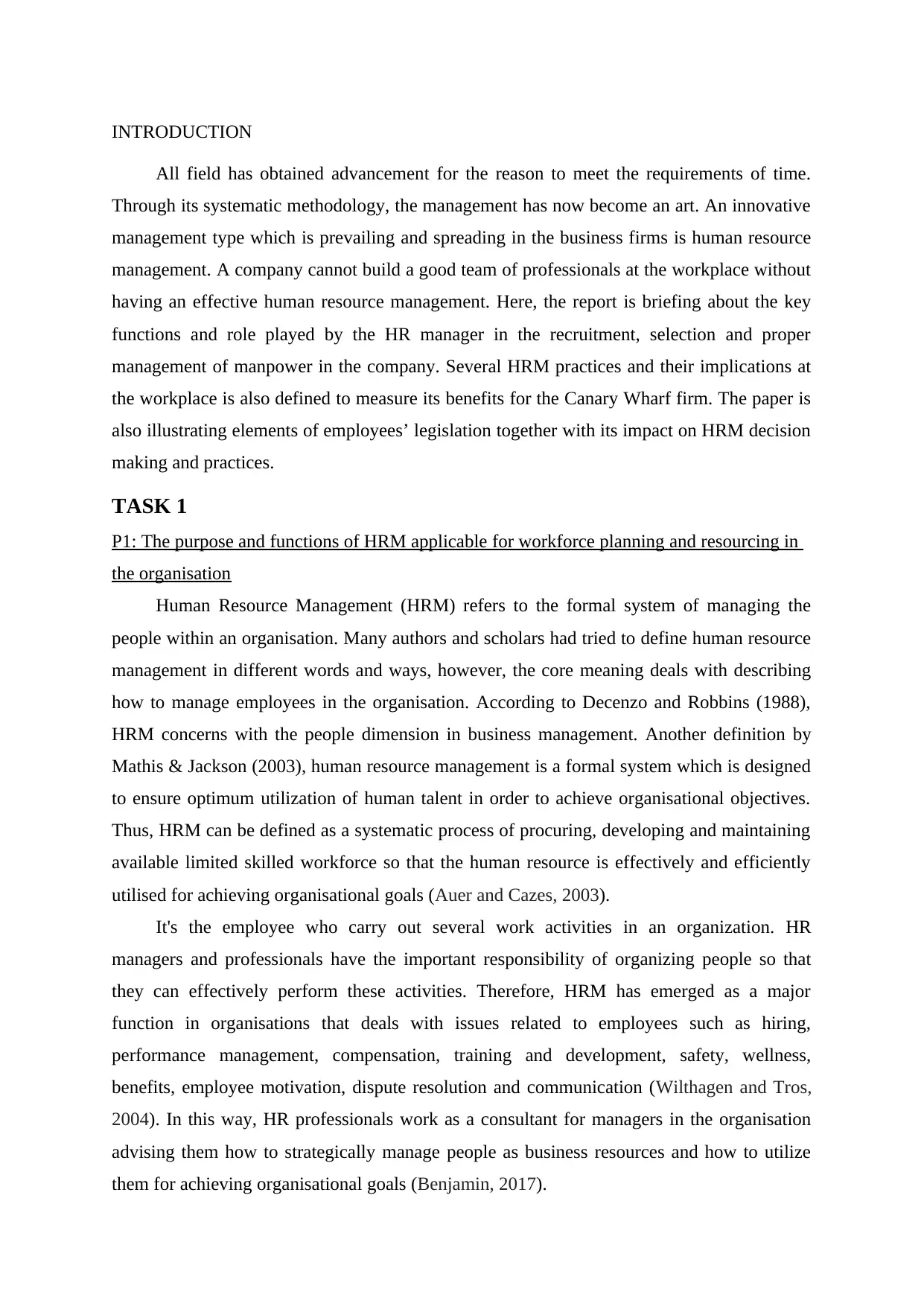
INTRODUCTION
All field has obtained advancement for the reason to meet the requirements of time.
Through its systematic methodology, the management has now become an art. An innovative
management type which is prevailing and spreading in the business firms is human resource
management. A company cannot build a good team of professionals at the workplace without
having an effective human resource management. Here, the report is briefing about the key
functions and role played by the HR manager in the recruitment, selection and proper
management of manpower in the company. Several HRM practices and their implications at
the workplace is also defined to measure its benefits for the Canary Wharf firm. The paper is
also illustrating elements of employees’ legislation together with its impact on HRM decision
making and practices.
TASK 1
P1: The purpose and functions of HRM applicable for workforce planning and resourcing in
the organisation
Human Resource Management (HRM) refers to the formal system of managing the
people within an organisation. Many authors and scholars had tried to define human resource
management in different words and ways, however, the core meaning deals with describing
how to manage employees in the organisation. According to Decenzo and Robbins (1988),
HRM concerns with the people dimension in business management. Another definition by
Mathis & Jackson (2003), human resource management is a formal system which is designed
to ensure optimum utilization of human talent in order to achieve organisational objectives.
Thus, HRM can be defined as a systematic process of procuring, developing and maintaining
available limited skilled workforce so that the human resource is effectively and efficiently
utilised for achieving organisational goals (Auer and Cazes, 2003).
It's the employee who carry out several work activities in an organization. HR
managers and professionals have the important responsibility of organizing people so that
they can effectively perform these activities. Therefore, HRM has emerged as a major
function in organisations that deals with issues related to employees such as hiring,
performance management, compensation, training and development, safety, wellness,
benefits, employee motivation, dispute resolution and communication (Wilthagen and Tros,
2004). In this way, HR professionals work as a consultant for managers in the organisation
advising them how to strategically manage people as business resources and how to utilize
them for achieving organisational goals (Benjamin, 2017).
All field has obtained advancement for the reason to meet the requirements of time.
Through its systematic methodology, the management has now become an art. An innovative
management type which is prevailing and spreading in the business firms is human resource
management. A company cannot build a good team of professionals at the workplace without
having an effective human resource management. Here, the report is briefing about the key
functions and role played by the HR manager in the recruitment, selection and proper
management of manpower in the company. Several HRM practices and their implications at
the workplace is also defined to measure its benefits for the Canary Wharf firm. The paper is
also illustrating elements of employees’ legislation together with its impact on HRM decision
making and practices.
TASK 1
P1: The purpose and functions of HRM applicable for workforce planning and resourcing in
the organisation
Human Resource Management (HRM) refers to the formal system of managing the
people within an organisation. Many authors and scholars had tried to define human resource
management in different words and ways, however, the core meaning deals with describing
how to manage employees in the organisation. According to Decenzo and Robbins (1988),
HRM concerns with the people dimension in business management. Another definition by
Mathis & Jackson (2003), human resource management is a formal system which is designed
to ensure optimum utilization of human talent in order to achieve organisational objectives.
Thus, HRM can be defined as a systematic process of procuring, developing and maintaining
available limited skilled workforce so that the human resource is effectively and efficiently
utilised for achieving organisational goals (Auer and Cazes, 2003).
It's the employee who carry out several work activities in an organization. HR
managers and professionals have the important responsibility of organizing people so that
they can effectively perform these activities. Therefore, HRM has emerged as a major
function in organisations that deals with issues related to employees such as hiring,
performance management, compensation, training and development, safety, wellness,
benefits, employee motivation, dispute resolution and communication (Wilthagen and Tros,
2004). In this way, HR professionals work as a consultant for managers in the organisation
advising them how to strategically manage people as business resources and how to utilize
them for achieving organisational goals (Benjamin, 2017).
⊘ This is a preview!⊘
Do you want full access?
Subscribe today to unlock all pages.

Trusted by 1+ million students worldwide
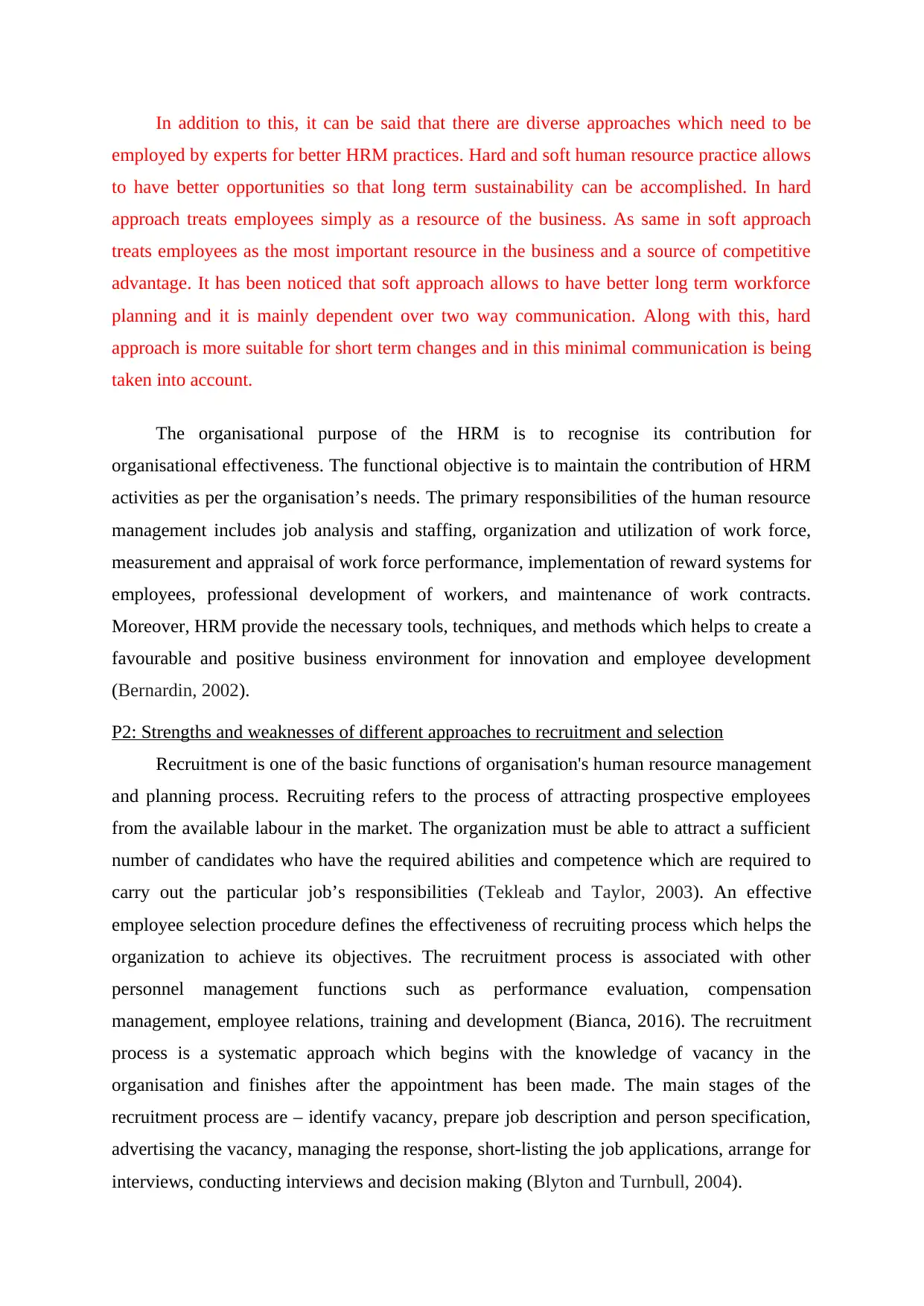
In addition to this, it can be said that there are diverse approaches which need to be
employed by experts for better HRM practices. Hard and soft human resource practice allows
to have better opportunities so that long term sustainability can be accomplished. In hard
approach treats employees simply as a resource of the business. As same in soft approach
treats employees as the most important resource in the business and a source of competitive
advantage. It has been noticed that soft approach allows to have better long term workforce
planning and it is mainly dependent over two way communication. Along with this, hard
approach is more suitable for short term changes and in this minimal communication is being
taken into account.
The organisational purpose of the HRM is to recognise its contribution for
organisational effectiveness. The functional objective is to maintain the contribution of HRM
activities as per the organisation’s needs. The primary responsibilities of the human resource
management includes job analysis and staffing, organization and utilization of work force,
measurement and appraisal of work force performance, implementation of reward systems for
employees, professional development of workers, and maintenance of work contracts.
Moreover, HRM provide the necessary tools, techniques, and methods which helps to create a
favourable and positive business environment for innovation and employee development
(Bernardin, 2002).
P2: Strengths and weaknesses of different approaches to recruitment and selection
Recruitment is one of the basic functions of organisation's human resource management
and planning process. Recruiting refers to the process of attracting prospective employees
from the available labour in the market. The organization must be able to attract a sufficient
number of candidates who have the required abilities and competence which are required to
carry out the particular job’s responsibilities (Tekleab and Taylor, 2003). An effective
employee selection procedure defines the effectiveness of recruiting process which helps the
organization to achieve its objectives. The recruitment process is associated with other
personnel management functions such as performance evaluation, compensation
management, employee relations, training and development (Bianca, 2016). The recruitment
process is a systematic approach which begins with the knowledge of vacancy in the
organisation and finishes after the appointment has been made. The main stages of the
recruitment process are – identify vacancy, prepare job description and person specification,
advertising the vacancy, managing the response, short-listing the job applications, arrange for
interviews, conducting interviews and decision making (Blyton and Turnbull, 2004).
employed by experts for better HRM practices. Hard and soft human resource practice allows
to have better opportunities so that long term sustainability can be accomplished. In hard
approach treats employees simply as a resource of the business. As same in soft approach
treats employees as the most important resource in the business and a source of competitive
advantage. It has been noticed that soft approach allows to have better long term workforce
planning and it is mainly dependent over two way communication. Along with this, hard
approach is more suitable for short term changes and in this minimal communication is being
taken into account.
The organisational purpose of the HRM is to recognise its contribution for
organisational effectiveness. The functional objective is to maintain the contribution of HRM
activities as per the organisation’s needs. The primary responsibilities of the human resource
management includes job analysis and staffing, organization and utilization of work force,
measurement and appraisal of work force performance, implementation of reward systems for
employees, professional development of workers, and maintenance of work contracts.
Moreover, HRM provide the necessary tools, techniques, and methods which helps to create a
favourable and positive business environment for innovation and employee development
(Bernardin, 2002).
P2: Strengths and weaknesses of different approaches to recruitment and selection
Recruitment is one of the basic functions of organisation's human resource management
and planning process. Recruiting refers to the process of attracting prospective employees
from the available labour in the market. The organization must be able to attract a sufficient
number of candidates who have the required abilities and competence which are required to
carry out the particular job’s responsibilities (Tekleab and Taylor, 2003). An effective
employee selection procedure defines the effectiveness of recruiting process which helps the
organization to achieve its objectives. The recruitment process is associated with other
personnel management functions such as performance evaluation, compensation
management, employee relations, training and development (Bianca, 2016). The recruitment
process is a systematic approach which begins with the knowledge of vacancy in the
organisation and finishes after the appointment has been made. The main stages of the
recruitment process are – identify vacancy, prepare job description and person specification,
advertising the vacancy, managing the response, short-listing the job applications, arrange for
interviews, conducting interviews and decision making (Blyton and Turnbull, 2004).
Paraphrase This Document
Need a fresh take? Get an instant paraphrase of this document with our AI Paraphraser
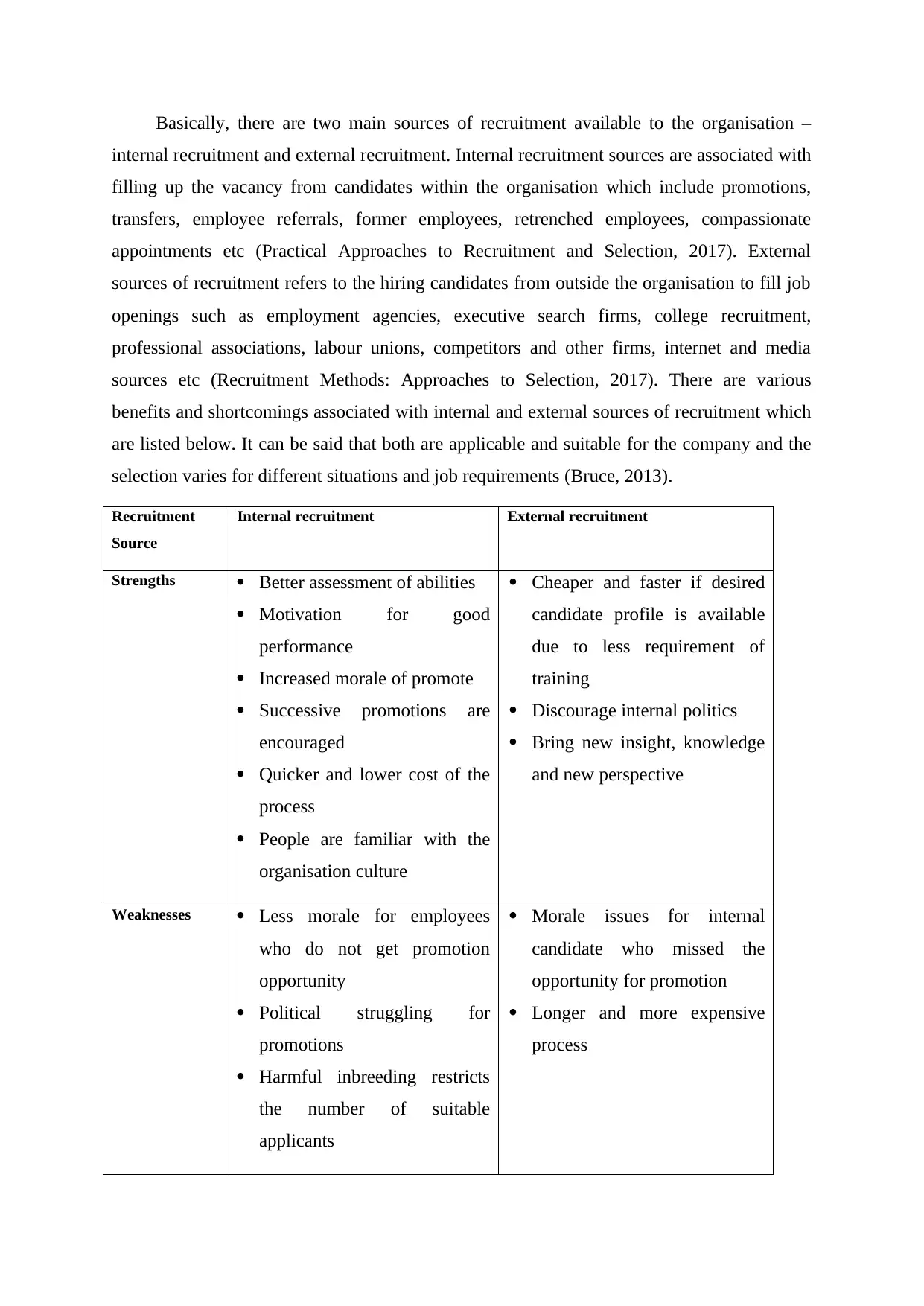
Basically, there are two main sources of recruitment available to the organisation –
internal recruitment and external recruitment. Internal recruitment sources are associated with
filling up the vacancy from candidates within the organisation which include promotions,
transfers, employee referrals, former employees, retrenched employees, compassionate
appointments etc (Practical Approaches to Recruitment and Selection, 2017). External
sources of recruitment refers to the hiring candidates from outside the organisation to fill job
openings such as employment agencies, executive search firms, college recruitment,
professional associations, labour unions, competitors and other firms, internet and media
sources etc (Recruitment Methods: Approaches to Selection, 2017). There are various
benefits and shortcomings associated with internal and external sources of recruitment which
are listed below. It can be said that both are applicable and suitable for the company and the
selection varies for different situations and job requirements (Bruce, 2013).
Recruitment
Source
Internal recruitment External recruitment
Strengths Better assessment of abilities
Motivation for good
performance
Increased morale of promote
Successive promotions are
encouraged
Quicker and lower cost of the
process
People are familiar with the
organisation culture
Cheaper and faster if desired
candidate profile is available
due to less requirement of
training
Discourage internal politics
Bring new insight, knowledge
and new perspective
Weaknesses Less morale for employees
who do not get promotion
opportunity
Political struggling for
promotions
Harmful inbreeding restricts
the number of suitable
applicants
Morale issues for internal
candidate who missed the
opportunity for promotion
Longer and more expensive
process
internal recruitment and external recruitment. Internal recruitment sources are associated with
filling up the vacancy from candidates within the organisation which include promotions,
transfers, employee referrals, former employees, retrenched employees, compassionate
appointments etc (Practical Approaches to Recruitment and Selection, 2017). External
sources of recruitment refers to the hiring candidates from outside the organisation to fill job
openings such as employment agencies, executive search firms, college recruitment,
professional associations, labour unions, competitors and other firms, internet and media
sources etc (Recruitment Methods: Approaches to Selection, 2017). There are various
benefits and shortcomings associated with internal and external sources of recruitment which
are listed below. It can be said that both are applicable and suitable for the company and the
selection varies for different situations and job requirements (Bruce, 2013).
Recruitment
Source
Internal recruitment External recruitment
Strengths Better assessment of abilities
Motivation for good
performance
Increased morale of promote
Successive promotions are
encouraged
Quicker and lower cost of the
process
People are familiar with the
organisation culture
Cheaper and faster if desired
candidate profile is available
due to less requirement of
training
Discourage internal politics
Bring new insight, knowledge
and new perspective
Weaknesses Less morale for employees
who do not get promotion
opportunity
Political struggling for
promotions
Harmful inbreeding restricts
the number of suitable
applicants
Morale issues for internal
candidate who missed the
opportunity for promotion
Longer and more expensive
process
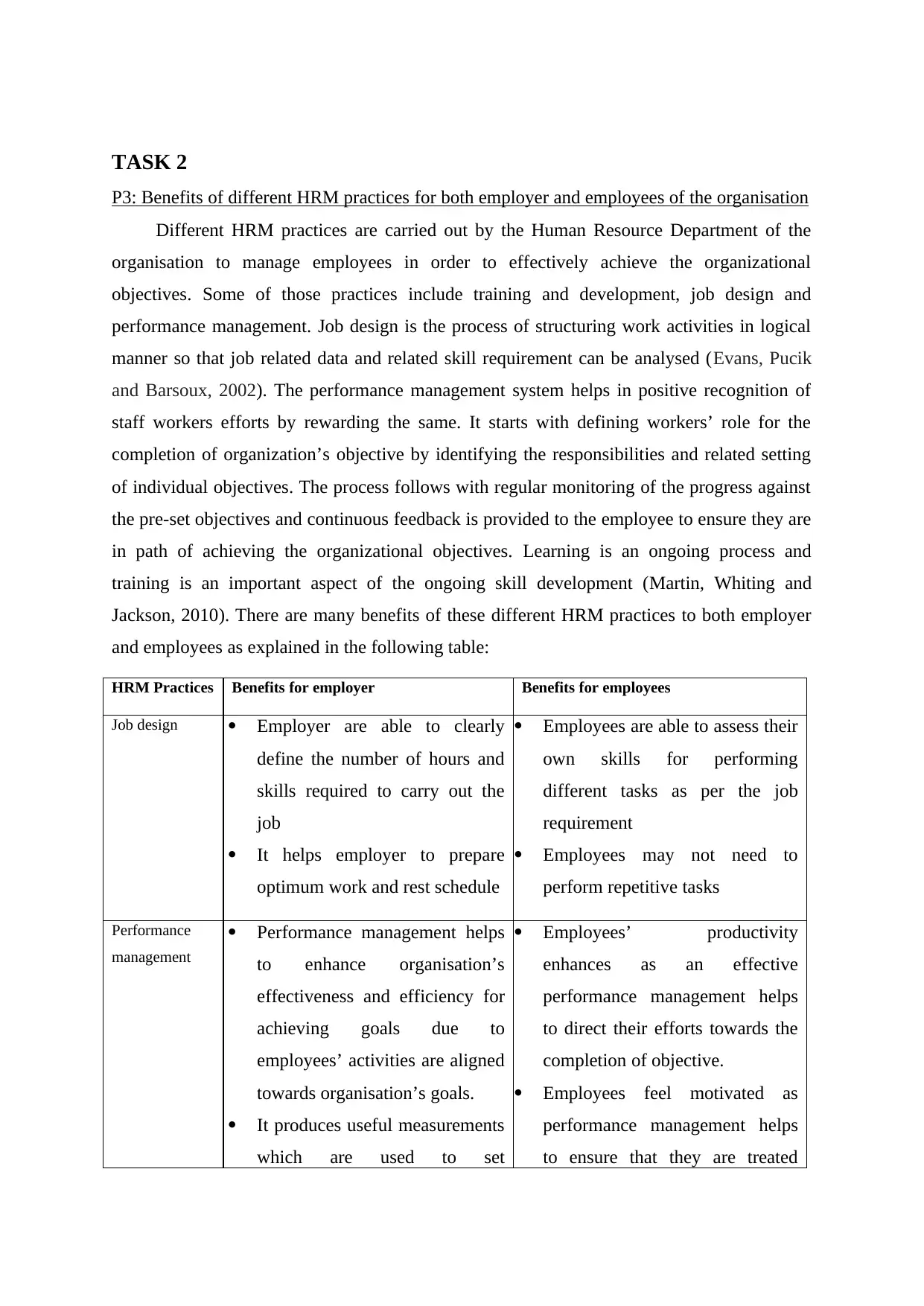
TASK 2
P3: Benefits of different HRM practices for both employer and employees of the organisation
Different HRM practices are carried out by the Human Resource Department of the
organisation to manage employees in order to effectively achieve the organizational
objectives. Some of those practices include training and development, job design and
performance management. Job design is the process of structuring work activities in logical
manner so that job related data and related skill requirement can be analysed (Evans, Pucik
and Barsoux, 2002). The performance management system helps in positive recognition of
staff workers efforts by rewarding the same. It starts with defining workers’ role for the
completion of organization’s objective by identifying the responsibilities and related setting
of individual objectives. The process follows with regular monitoring of the progress against
the pre-set objectives and continuous feedback is provided to the employee to ensure they are
in path of achieving the organizational objectives. Learning is an ongoing process and
training is an important aspect of the ongoing skill development (Martin, Whiting and
Jackson, 2010). There are many benefits of these different HRM practices to both employer
and employees as explained in the following table:
HRM Practices Benefits for employer Benefits for employees
Job design Employer are able to clearly
define the number of hours and
skills required to carry out the
job
It helps employer to prepare
optimum work and rest schedule
Employees are able to assess their
own skills for performing
different tasks as per the job
requirement
Employees may not need to
perform repetitive tasks
Performance
management
Performance management helps
to enhance organisation’s
effectiveness and efficiency for
achieving goals due to
employees’ activities are aligned
towards organisation’s goals.
It produces useful measurements
which are used to set
Employees’ productivity
enhances as an effective
performance management helps
to direct their efforts towards the
completion of objective.
Employees feel motivated as
performance management helps
to ensure that they are treated
P3: Benefits of different HRM practices for both employer and employees of the organisation
Different HRM practices are carried out by the Human Resource Department of the
organisation to manage employees in order to effectively achieve the organizational
objectives. Some of those practices include training and development, job design and
performance management. Job design is the process of structuring work activities in logical
manner so that job related data and related skill requirement can be analysed (Evans, Pucik
and Barsoux, 2002). The performance management system helps in positive recognition of
staff workers efforts by rewarding the same. It starts with defining workers’ role for the
completion of organization’s objective by identifying the responsibilities and related setting
of individual objectives. The process follows with regular monitoring of the progress against
the pre-set objectives and continuous feedback is provided to the employee to ensure they are
in path of achieving the organizational objectives. Learning is an ongoing process and
training is an important aspect of the ongoing skill development (Martin, Whiting and
Jackson, 2010). There are many benefits of these different HRM practices to both employer
and employees as explained in the following table:
HRM Practices Benefits for employer Benefits for employees
Job design Employer are able to clearly
define the number of hours and
skills required to carry out the
job
It helps employer to prepare
optimum work and rest schedule
Employees are able to assess their
own skills for performing
different tasks as per the job
requirement
Employees may not need to
perform repetitive tasks
Performance
management
Performance management helps
to enhance organisation’s
effectiveness and efficiency for
achieving goals due to
employees’ activities are aligned
towards organisation’s goals.
It produces useful measurements
which are used to set
Employees’ productivity
enhances as an effective
performance management helps
to direct their efforts towards the
completion of objective.
Employees feel motivated as
performance management helps
to ensure that they are treated
⊘ This is a preview!⊘
Do you want full access?
Subscribe today to unlock all pages.

Trusted by 1+ million students worldwide
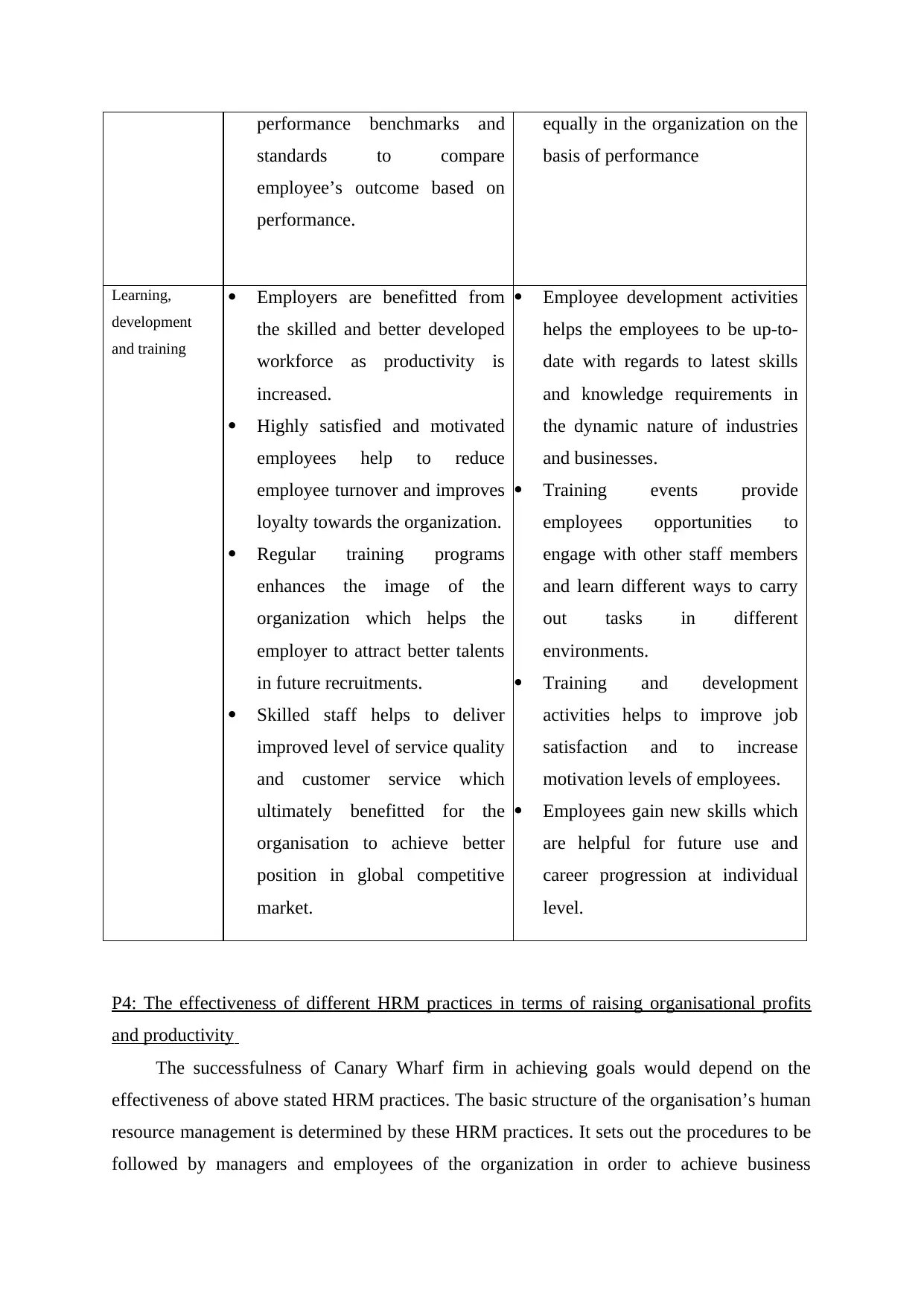
performance benchmarks and
standards to compare
employee’s outcome based on
performance.
equally in the organization on the
basis of performance
Learning,
development
and training
Employers are benefitted from
the skilled and better developed
workforce as productivity is
increased.
Highly satisfied and motivated
employees help to reduce
employee turnover and improves
loyalty towards the organization.
Regular training programs
enhances the image of the
organization which helps the
employer to attract better talents
in future recruitments.
Skilled staff helps to deliver
improved level of service quality
and customer service which
ultimately benefitted for the
organisation to achieve better
position in global competitive
market.
Employee development activities
helps the employees to be up-to-
date with regards to latest skills
and knowledge requirements in
the dynamic nature of industries
and businesses.
Training events provide
employees opportunities to
engage with other staff members
and learn different ways to carry
out tasks in different
environments.
Training and development
activities helps to improve job
satisfaction and to increase
motivation levels of employees.
Employees gain new skills which
are helpful for future use and
career progression at individual
level.
P4: The effectiveness of different HRM practices in terms of raising organisational profits
and productivity
The successfulness of Canary Wharf firm in achieving goals would depend on the
effectiveness of above stated HRM practices. The basic structure of the organisation’s human
resource management is determined by these HRM practices. It sets out the procedures to be
followed by managers and employees of the organization in order to achieve business
standards to compare
employee’s outcome based on
performance.
equally in the organization on the
basis of performance
Learning,
development
and training
Employers are benefitted from
the skilled and better developed
workforce as productivity is
increased.
Highly satisfied and motivated
employees help to reduce
employee turnover and improves
loyalty towards the organization.
Regular training programs
enhances the image of the
organization which helps the
employer to attract better talents
in future recruitments.
Skilled staff helps to deliver
improved level of service quality
and customer service which
ultimately benefitted for the
organisation to achieve better
position in global competitive
market.
Employee development activities
helps the employees to be up-to-
date with regards to latest skills
and knowledge requirements in
the dynamic nature of industries
and businesses.
Training events provide
employees opportunities to
engage with other staff members
and learn different ways to carry
out tasks in different
environments.
Training and development
activities helps to improve job
satisfaction and to increase
motivation levels of employees.
Employees gain new skills which
are helpful for future use and
career progression at individual
level.
P4: The effectiveness of different HRM practices in terms of raising organisational profits
and productivity
The successfulness of Canary Wharf firm in achieving goals would depend on the
effectiveness of above stated HRM practices. The basic structure of the organisation’s human
resource management is determined by these HRM practices. It sets out the procedures to be
followed by managers and employees of the organization in order to achieve business
Paraphrase This Document
Need a fresh take? Get an instant paraphrase of this document with our AI Paraphraser
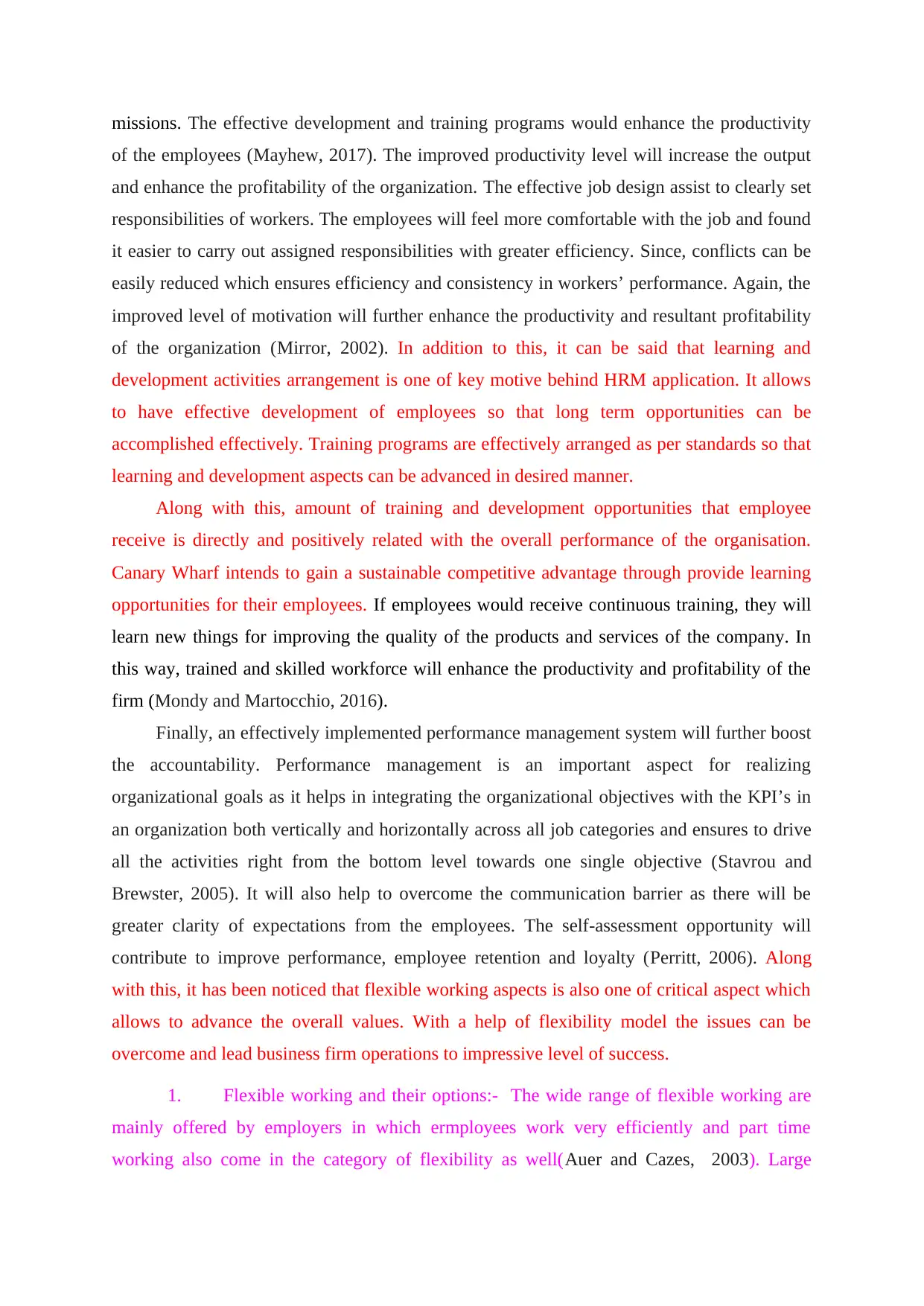
missions. The effective development and training programs would enhance the productivity
of the employees (Mayhew, 2017). The improved productivity level will increase the output
and enhance the profitability of the organization. The effective job design assist to clearly set
responsibilities of workers. The employees will feel more comfortable with the job and found
it easier to carry out assigned responsibilities with greater efficiency. Since, conflicts can be
easily reduced which ensures efficiency and consistency in workers’ performance. Again, the
improved level of motivation will further enhance the productivity and resultant profitability
of the organization (Mirror, 2002). In addition to this, it can be said that learning and
development activities arrangement is one of key motive behind HRM application. It allows
to have effective development of employees so that long term opportunities can be
accomplished effectively. Training programs are effectively arranged as per standards so that
learning and development aspects can be advanced in desired manner.
Along with this, amount of training and development opportunities that employee
receive is directly and positively related with the overall performance of the organisation.
Canary Wharf intends to gain a sustainable competitive advantage through provide learning
opportunities for their employees. If employees would receive continuous training, they will
learn new things for improving the quality of the products and services of the company. In
this way, trained and skilled workforce will enhance the productivity and profitability of the
firm (Mondy and Martocchio, 2016).
Finally, an effectively implemented performance management system will further boost
the accountability. Performance management is an important aspect for realizing
organizational goals as it helps in integrating the organizational objectives with the KPI’s in
an organization both vertically and horizontally across all job categories and ensures to drive
all the activities right from the bottom level towards one single objective (Stavrou and
Brewster, 2005). It will also help to overcome the communication barrier as there will be
greater clarity of expectations from the employees. The self-assessment opportunity will
contribute to improve performance, employee retention and loyalty (Perritt, 2006). Along
with this, it has been noticed that flexible working aspects is also one of critical aspect which
allows to advance the overall values. With a help of flexibility model the issues can be
overcome and lead business firm operations to impressive level of success.
1. Flexible working and their options:- The wide range of flexible working are
mainly offered by employers in which ermployees work very efficiently and part time
working also come in the category of flexibility as well(Auer and Cazes, 2003). Large
of the employees (Mayhew, 2017). The improved productivity level will increase the output
and enhance the profitability of the organization. The effective job design assist to clearly set
responsibilities of workers. The employees will feel more comfortable with the job and found
it easier to carry out assigned responsibilities with greater efficiency. Since, conflicts can be
easily reduced which ensures efficiency and consistency in workers’ performance. Again, the
improved level of motivation will further enhance the productivity and resultant profitability
of the organization (Mirror, 2002). In addition to this, it can be said that learning and
development activities arrangement is one of key motive behind HRM application. It allows
to have effective development of employees so that long term opportunities can be
accomplished effectively. Training programs are effectively arranged as per standards so that
learning and development aspects can be advanced in desired manner.
Along with this, amount of training and development opportunities that employee
receive is directly and positively related with the overall performance of the organisation.
Canary Wharf intends to gain a sustainable competitive advantage through provide learning
opportunities for their employees. If employees would receive continuous training, they will
learn new things for improving the quality of the products and services of the company. In
this way, trained and skilled workforce will enhance the productivity and profitability of the
firm (Mondy and Martocchio, 2016).
Finally, an effectively implemented performance management system will further boost
the accountability. Performance management is an important aspect for realizing
organizational goals as it helps in integrating the organizational objectives with the KPI’s in
an organization both vertically and horizontally across all job categories and ensures to drive
all the activities right from the bottom level towards one single objective (Stavrou and
Brewster, 2005). It will also help to overcome the communication barrier as there will be
greater clarity of expectations from the employees. The self-assessment opportunity will
contribute to improve performance, employee retention and loyalty (Perritt, 2006). Along
with this, it has been noticed that flexible working aspects is also one of critical aspect which
allows to advance the overall values. With a help of flexibility model the issues can be
overcome and lead business firm operations to impressive level of success.
1. Flexible working and their options:- The wide range of flexible working are
mainly offered by employers in which ermployees work very efficiently and part time
working also come in the category of flexibility as well(Auer and Cazes, 2003). Large
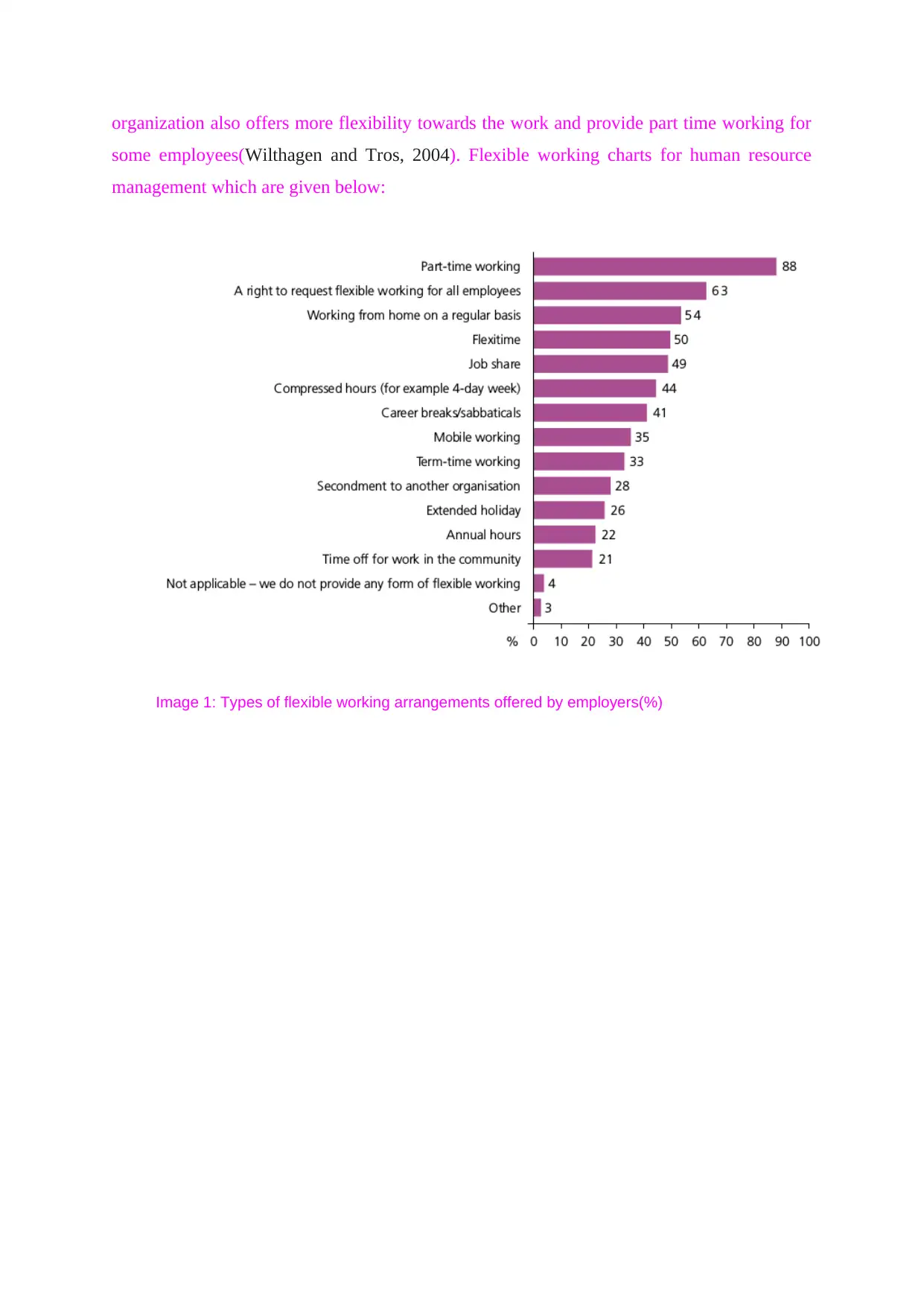
organization also offers more flexibility towards the work and provide part time working for
some employees(Wilthagen and Tros, 2004). Flexible working charts for human resource
management which are given below:
Image 1: Types of flexible working arrangements offered by employers(%)
some employees(Wilthagen and Tros, 2004). Flexible working charts for human resource
management which are given below:
Image 1: Types of flexible working arrangements offered by employers(%)
⊘ This is a preview!⊘
Do you want full access?
Subscribe today to unlock all pages.

Trusted by 1+ million students worldwide
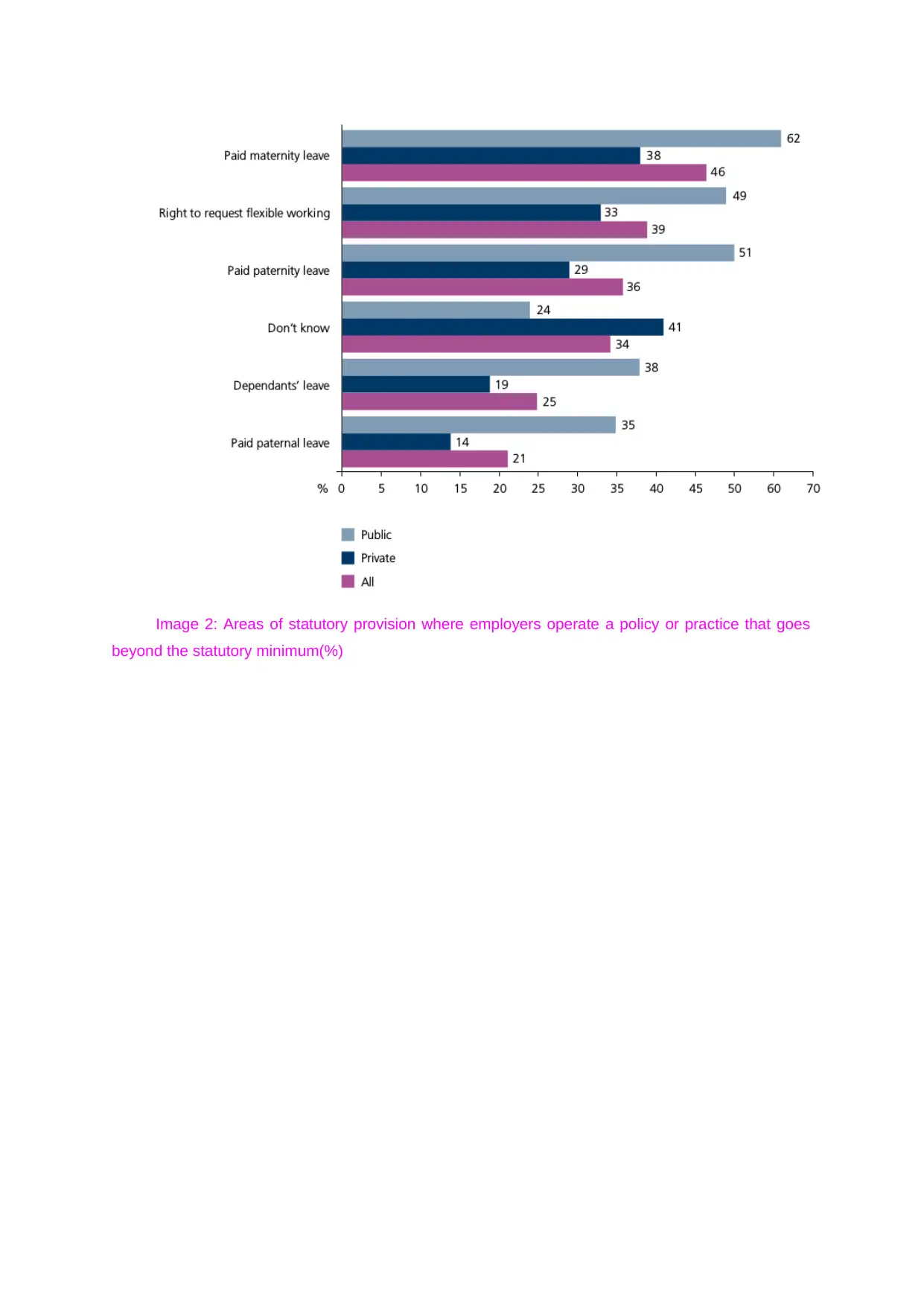
Image 2: Areas of statutory provision where employers operate a policy or practice that goes
beyond the statutory minimum(%)
beyond the statutory minimum(%)
Paraphrase This Document
Need a fresh take? Get an instant paraphrase of this document with our AI Paraphraser
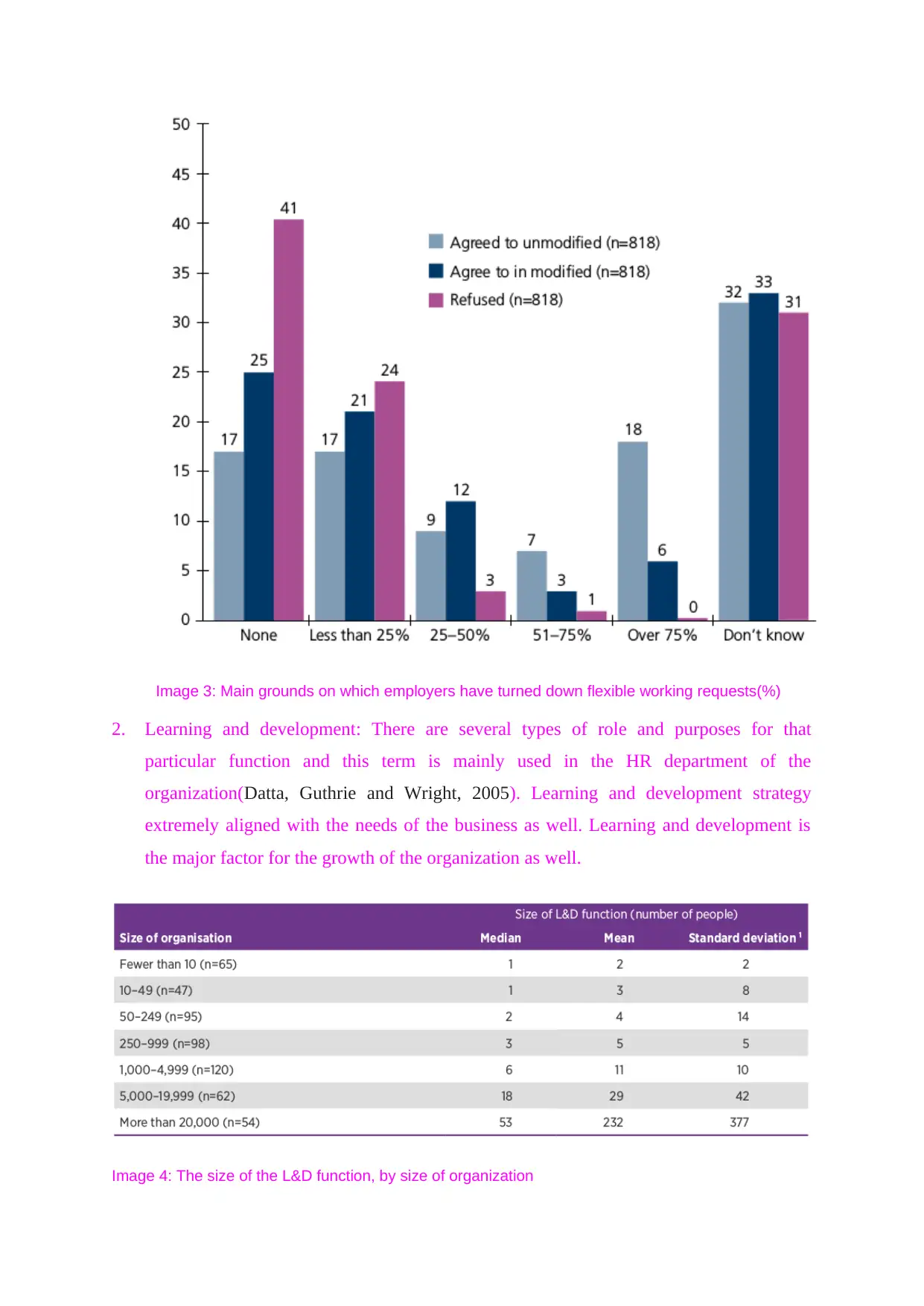
Image 3: Main grounds on which employers have turned down flexible working requests(%)
2. Learning and development: There are several types of role and purposes for that
particular function and this term is mainly used in the HR department of the
organization(Datta, Guthrie and Wright, 2005). Learning and development strategy
extremely aligned with the needs of the business as well. Learning and development is
the major factor for the growth of the organization as well.
Image 4: The size of the L&D function, by size of organization
2. Learning and development: There are several types of role and purposes for that
particular function and this term is mainly used in the HR department of the
organization(Datta, Guthrie and Wright, 2005). Learning and development strategy
extremely aligned with the needs of the business as well. Learning and development is
the major factor for the growth of the organization as well.
Image 4: The size of the L&D function, by size of organization
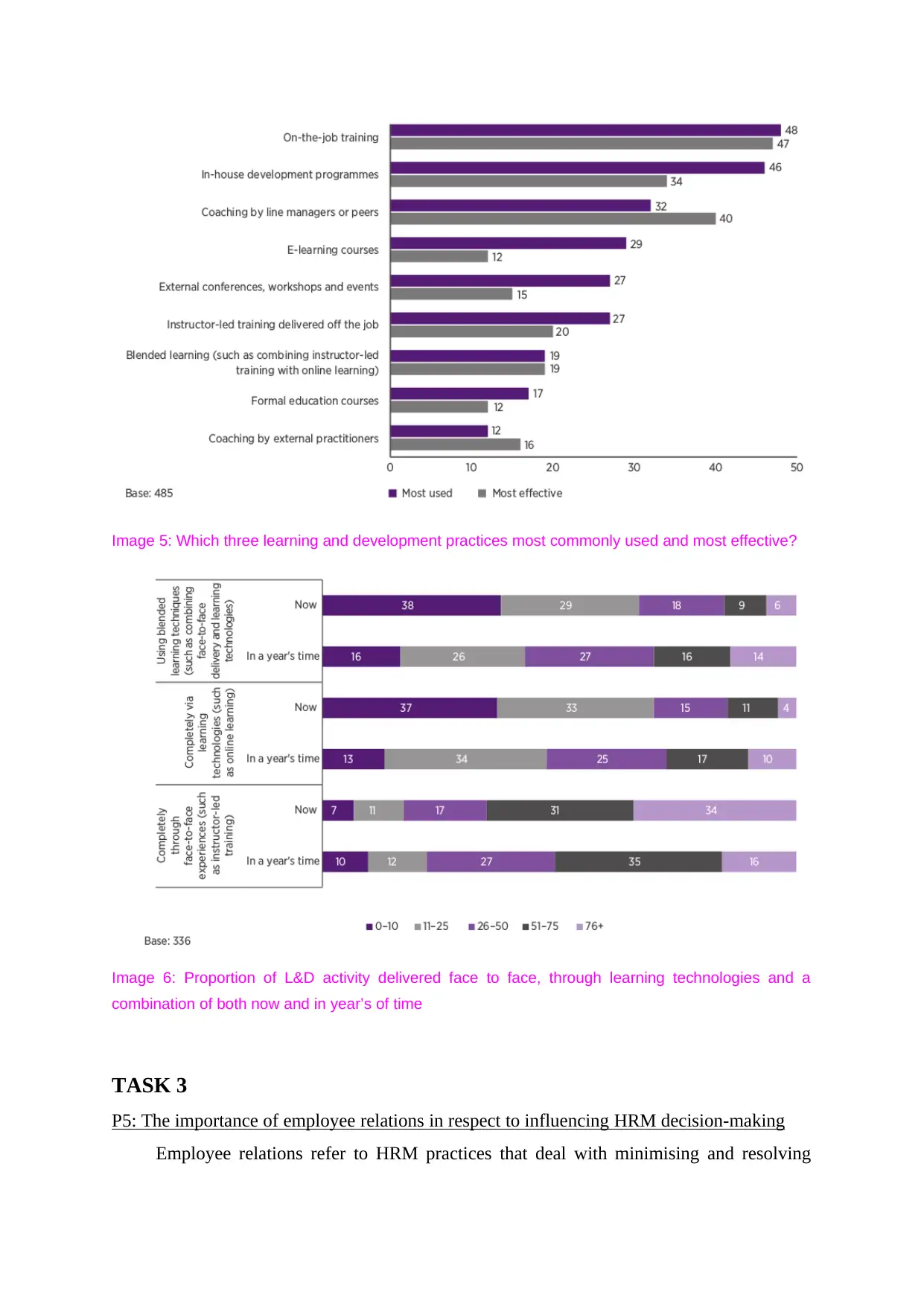
Image 5: Which three learning and development practices most commonly used and most effective?
Image 6: Proportion of L&D activity delivered face to face, through learning technologies and a
combination of both now and in year’s of time
TASK 3
P5: The importance of employee relations in respect to influencing HRM decision-making
Employee relations refer to HRM practices that deal with minimising and resolving
Image 6: Proportion of L&D activity delivered face to face, through learning technologies and a
combination of both now and in year’s of time
TASK 3
P5: The importance of employee relations in respect to influencing HRM decision-making
Employee relations refer to HRM practices that deal with minimising and resolving
⊘ This is a preview!⊘
Do you want full access?
Subscribe today to unlock all pages.

Trusted by 1+ million students worldwide
1 out of 19
Related Documents
Your All-in-One AI-Powered Toolkit for Academic Success.
+13062052269
info@desklib.com
Available 24*7 on WhatsApp / Email
![[object Object]](/_next/static/media/star-bottom.7253800d.svg)
Unlock your academic potential
Copyright © 2020–2025 A2Z Services. All Rights Reserved. Developed and managed by ZUCOL.





